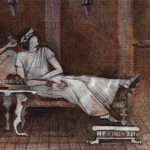I have gazed at Kennedy’s multiple spine films taken before and after his first back surgery. There was no straightening of his spine, squaring of his vertebrae, or shiny vertebral corners that heralded syndesmophyte formation. However, his left sacroiliac joint appeared narrowed in the X-rays taken following his back operation. The surgery failed to improve his pain, and Kennedy resorted to using crutches to get around.
Ten years later, because of his considerable pain and difficulty walking, Kennedy decided to listen to the advice of his surgeon at the Hospital for Special Surgery in New York City, and proceed with a spinal fusion. This was an extremely risky procedure at the time, given Kennedy’s history of Addison’s disease, a diagnosis that was made seven years earlier. His surgical team described their procedure and the perioperative course in a case report published in 1955. They claimed that the “patient had a smooth postoperative course” marked by only “minor complications.”4 In fact, John Kennedy nearly died; three days after surgery, he suffered both a urinary tract infection and a “mild wound infection,” which turned out to be a serious staphylococcal infection. He slipped into a coma and was given the last rites of the church. Miraculously, he recovered and four months later was well enough to undergo a third back surgery, this time to remove the infected hardware from his back.
Till the end of his days, Kennedy suffered from severe back pain. He relied on crutches, painkillers, and trigger-point injections to get him through each day. And there was one other device that he depended on—his back brace. According to Dallek, “On November 22, 1963, Kennedy was, as always, wearing a corset-like back brace as he rode through Dallas. Oswald’s first bullet struck him in the back of the neck. Were it not for the back brace, which held him erect, the second, fatal shot to the head might not have found its mark.”5
Dr. Helfgott is physician editor of The Rheumatologist and associate professor of medicine in the division of rheumatology, immunology, and allergy at Harvard Medical School in Boston.
References
- Dallek R. The medical ordeals of JFK. The Atlantic Magazine. December 2002. Available at http://www.theatlantic.com/magazine/archive/2002/12/the-medical-ordeals-of-jfk/305572/?single_page=true. Accessed October 15, 2013.
- Mandel LR. Endocrine and autoimmune aspects of the health history of John F. Kennedy. Ann Intern Med. 2009;151:350-354.
- Giglio JN. Growing up Kennedy: The role of medical ailments in the life of JFK, 1920-1957. J Fam Hist. 2006;31:358-385.
- Nicholas JA, Burstein CL, Umberger C, Wilson PD. Management of adrenocortical insufficiency during surgery. Arch Surg. 1955;71:739.
- Dallek R. An unfinished life: John F. Kennedy 1917-1963. New York: Little Brown & Company; 2001.


